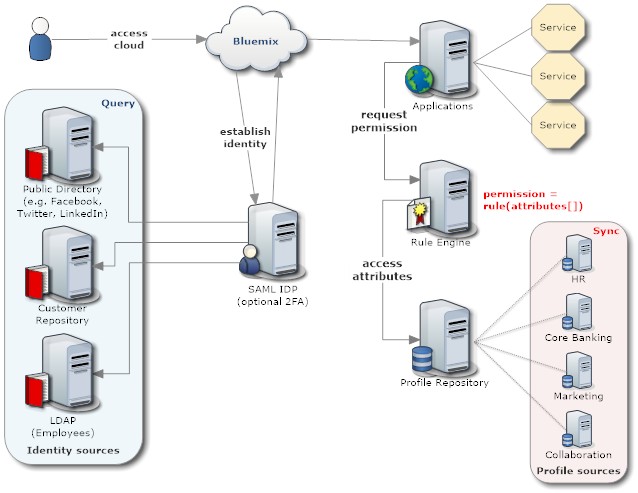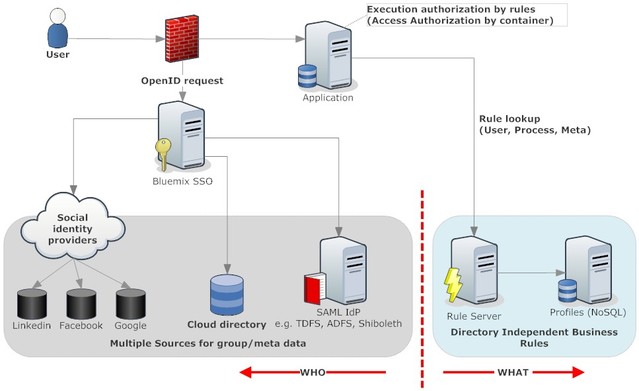Identiy in the age of cloud
Who is using your application and what they can do has evolved over the years. With cloud computing and the distribution of identity sources, the next iteration of this evolution is pending. A little look into the history:
 <
<

As usual YMMV
- In the beginning was the user table (or flatfile) with a column for user name and (initially unencrypted) password. The world was good, of course only until you had enough applications and users complaint bitterly
- In the next iteration access to the network or intranet was moved to a central directory. A lot of authentication became: if (s)he can get to the server, we pick up the user name
- Other applications started to use that central directory to look up users, either via LDAP or propriety protocols. So while the password was the same, users entered it repeatedly
- Along came a flood of single sign-on frameworks, that mitigated identity information between applications, based on a central directory. Some used an adapter approach (like Tivoli Access Manager), others a standardised protocol like LTPA or SPNEGO
- All solutions are based on a carefully guarded and maintained central directory (or more than one). These directories are under full corporate control and usually defended against any attempt to alter or extend the functionality. (Some of them can't roll back schema changes and are build on fragile storage)
- Besides user identity they provide groups and sometimes roles. Often these roles are limited to directory capabilities (e.g. admin, printer-user) and applications are left to their own devices to map users/groups to roles (e.g. the ACL in IBM Notes)
- The core directory is limited to company employees and is often synchronised with a HR directory. Strategies for inclusion of customers, partners and suppliers tend to be point solutions
 <
<
Core tenants of Identity
- An Identity Provider (IdP) is responsible to establish identity. The current standard for that is SAML, but that's not the only way. The permission delegation known as OAuth, to the confusion of many architects, can be used as authentication substitute (I allow you to read from my LinkedIn profile my name and email via OAuth and you then take that values as my identity). In any case, the cloud applications shouldn't care, they just ask the respective service "Who is this person?". Since the sources can be very different, that's all he SSO will (and shall) provide
- The next level is the basic access control. I would place that responsibility on the router, but depending on cloud capability each application needs to check itself. Depending on the security need an application might show a home page with information how to request access or deflect to an error (eventually hide behind a 404). In a micro service world an application access service could provide this information. A web UI could also use that service to render a list of available applications for the current user
- It is getting more interesting now. In classical application any action (including reading and rendering data) is linked to a user role or permission. These permissions live in code. In a cloud micro service architecture the right to action is better delegated to a rule service. This allows for more flexibility and user control. To obtain a permission a context object is handed to the rule service (XML or JSON), that in its bare minimum contains just the user identity. In more complex cases it could be value, project name, decision time etc. The rule engine then approves or denies the action
- A secondary rule service can go an lookup process information (e.g. who is the approver for a 5M loan to ACME Inc). Extracting the rules from code into a Rule Engine makes it more flexible and business accessible (You want to be good at caching)
- The rule engine or other services use a profile service to lookup user properties. This is where group memberships and roles live.
One could succumb to the temptation to let that service depend on an LDAP corporate directory, only to realise that the guardians will lock him down (again). The better approach is the profile service synchronises properties that are maintained in other systems and presents the union of them to requesting applications - So a key difference between the IdP and the profile service: the IdP has one task and one only, it performs that through lookups. The profile service provides profile information (in different combinations) that it obtained through direct entry or synchronisation
- The diagram is a high level one, the rule engine and profile service might themselves be composed of multiple micro services. This is beyond this article

As usual YMMV
Posted by Stephan H Wissel on 23 August 2015 | Comments (0) | categories: Bluemix Cloud Computing